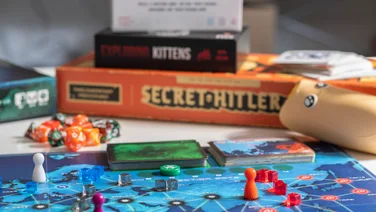To help us provide you with free impartial advice, we may earn a commission if you buy through links on our site. Learn more



Christine Lyons lives an edgy kind of life amid San Francisco’s nascent 1950’s beat poetry scene, while her husband Joe languishes across the water, on the rock of Alcatraz. You take control of how their futures unfold and how their relationship withstands the pressures of loneliness, threats from the mob and harassment from law enforcement.
The setting and characters touch on the freedoms that defined the beat subculture, with non-judgemental portrayals of same-sex relationships and drug use, although it’s hardly a scene of Burroughsian debauchery, and some slang terms are a little wide of the mark. Even so, the unpleasant spectre of racism and hostility towards Joe and Christine’s interracial relationship in an America where the Civil Rights Movement was still struggling against oppression isn’t skipped over.

The game is split between Joe’s attempt to assemble an escape plan in Alcatraz and Christine’s life in San Francisco
Joe’s scenes in the prison all take place during the day, while Christine’s life goes on at night. It’s not entirely obvious how the timeline functions; We initially assumed that each character’s actions took place in a single day or night, but were proved wrong in a later puzzle which sees the two exchanging messages via a surprisingly hip Catholic priest whose work encompasses both the prison and a city cathedral. You can switch between Joe and Christine at any time, so if you get stuck on one set of puzzles, there’s always another to keep you busy.
Each character has their part to play in the escape plan. As Joe works out how to flee from America’s most notoriously inescapable prison, it falls to Christine to recover Joe’s loot and pull together a getaway plan. It’s also Christine’s decisions that have the greatest impact on the eventual outcome of the game: after being threatened by both Joe’s former partner in crime, and the police officer who put Joe in jail for armed robbery, she is given numerous opportunities to betray him. Each of these choices affects the way the game unfolds, and whether the couple make their way to freedom or their marriage comes to a very messy end.

When Christine isn’t being threatened by gangsters, she’s making connections in the art world
Neither Joe nor Christine is a paragon of virtue: both are more than willing to turn to crime as a means to an end, and both have to make some hard ethical choices to attain their goals. We agonised over some necessary evils while playing, with some of them being literal life and death decisions.
Most of the game’s puzzles are clever, well constructed and tie in beautifully with the plot. Different objects and people change their responses as the plot progresses, too. We were irritated by a few early puzzles, but most were more about intellectual effort than clicking on everything in the area. A particularly elegant sequence has Christine tracking down the hidden keys to Joe’s stash of money, distributed among her flakey artistic friends.
We got a good seven hours of gameplay out of 1954: Alcatraz, in two solid evenings of gaming; we didn’t even contemplate doing anything else with our time until we’d seen how it all ended. Unlike most adventure games, there’s a definite incentive to go back and replay events to see the alternate puzzles and outcomes too. The voice acting is great, while the moody graphics and realistic locations give the game a sense of authenticity. With well-balanced puzzles, a unique setting and a storyline that keeps you wanting more, 1954: Alcatraz is an excellent adventure with a welcome range of mature themes. It’s available to buy from GOG.com for a bargain $20, which is around £12.
| Details | |
|---|---|
| Price | £12 |
| Details | http://daedalic.de/alcatraz/en/ |
| Rating | ***** |





